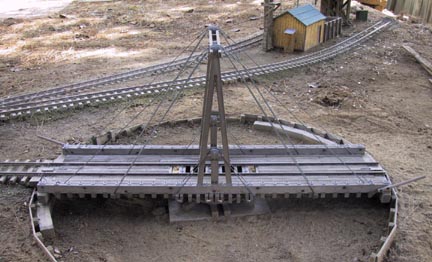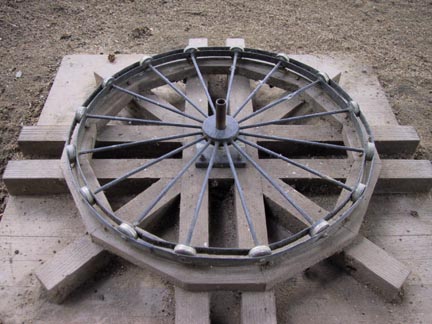

The turntable at Tecolote Creek is a typical gallows style turntable. This type of turntable was built from the beginning of railroading. My particular model is inspired by the table at Laws, CA on the Carson and Colorado. I started with a two part article in Narrow Gauge Gazette, No/Deck 1989, and Jan/Fed 1990, by Al Armitage. I have made a few modifications from that design.
Since the Big River is a single ended railroad, a functional turntable is essential. The entire structure is tight grained, heart redwood, held together with hundreds of 0-80 nuts on 1/16" dia. threaded rods, with numerous pewter casting. This model has lived outside for over 8 years.
The table bridge pivots on a central roller bearing called a spider. The spider is supported below by a ring rail on a wooden base. A matching ring rail on the bottom of the bridge carries the weight of the table. Four tension rods running across the bridge support the load of the vertical posts. The posts support five pairs of tension rods, three pairs at the top and two pairs lower down, which support the outer ends of the pairs of main side beams. The tension rods ride in cast chairs where they pass over the posts. The notched side beams are bolted to cross braces, which carry the rails and a walkway deck. Each nut is supported by a cast washer fitting.
In this model there are a pair of rollers at each end to support the weight of an engine as it moves on or off of the table. These rollers are supported by large wooden block at the edge of the turntable pit, where the tracks approach the table.
This shows the overall pit, with the end support blocks by the lead tracks, the pit wall to retain the earth around the pit, and the central foundation structure which carries the lower ring rail. There is a pivot post in the middle of the foundation which supports none of the weight.
Here is the roller bearing spider. The inner and outer flat stock capture the 16 roller wheels, and hold them on the axles at the correct distance from the center so that they run on top of the ring rail. The whole spider pivots on the central post.

Here is a closeup of the spider rollers supporting the table superstructure.
This shows the ends of the crosswise tension rods, and the details of the lower sets of side beam tension rods. The tension rods run on cast chairs at where they cross the top of the posts. The lower ends of the posts are captured in square cast cups. All the major rod nuts are supported by cast plate washers.
Here is half of the bridge with rails and walkway decking. Notice the pairs of side beams. Threaded rods run between the side beams and through the lower cross beams, with a nut and cast washer plate on each end.
Here are details of the alignment latch. When the bridge has been pushed to the correct location, a lever on the right is throw which moved the flat plate out to engage with dogs on the fixed side of the lead track. This ensures that the bridge won't shift when the locomotive moves onto the bridge. At the extreme right are some of the cast washer plates.
Here are the clevis details for the tension rods running over the top of the vertical posts.
Overall pictures of the turntable.